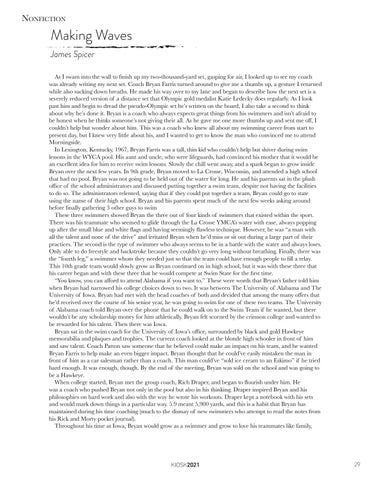nonFiction
Making Waves James Spicer was already writing my next set. Coach Bryan Farris turned around to give me a thumbs up, a gesture I returned while also sucking down breaths. He made his way over to my lane and began to describe how the next set is a severely reduced version of a distance set that Olympic gold medalist Katie Ledecky does regularly. As I look past him and begin to dread the pseudo-Olympic set he’s written on the board, I also take a second to think about why he’s done it. Bryan is a coach who always expects great things from his swimmers and isn’t afraid to couldn’t help but wonder about him. This was a coach who knew all about my swimming career from start to present day, but I knew very little about his, and I wanted to get to know the man who convinced me to attend Morningside. In Lexington, Kentucky, 1967, Bryan Farris was a tall, thin kid who couldn’t help but shiver during swim lessons in the WYCA pool. His aunt and uncle, who were lifeguards, had convinced his mother that it would be an excellent idea for him to receive swim lessons. Slowly the chill went away, and a spark began to grow inside Bryan over the next few years. In 9th grade, Bryan moved to La Crosse, Wisconsin, and attended a high school that had no pool. Bryan was not going to be held out of the water for long. He and his parents sat in the plush to do so. The administrators relented, saying that if they could put together a team, Bryan could go to state using the name of their high school. Bryan and his parents spent much of the next few weeks asking around These three swimmers showed Bryan the three out of four kinds of swimmers that existed within the sport. There was his teammate who seemed to glide through the La Crosse YMCA’s water with ease, always popping all the talent and none of the drive” and irritated Bryan when he’d miss or sit out during a large part of their practices. The second is the type of swimmer who always seems to be in a battle with the water and always loses. Only able to do freestyle and backstroke because they couldn’t go very long without breathing. Finally, there was This 10th grade team would slowly grow as Bryan continued on in high school, but it was with these three that when Bryan had narrowed his college choices down to two. It was between The University of Alabama and The he’d received over the course of his senior year, he was going to swim for one of these two teams. The University of Alabama coach told Bryan over the phone that he could walk on to the Swim Team if he wanted, but there wouldn’t be any scholarship money for him athletically. Bryan felt scorned by the crimson college and wanted to be rewarded for his talent. Then there was Iowa. memorabilia and plaques and trophies. The current coach looked at the blonde high schooler in front of him and saw talent. Coach Patton saw someone that he believed could make an impact on his team, and he wanted Bryan Farris to help make an even bigger impact. Bryan thought that he could’ve easily mistaken the man in front of him as a car salesman rather than a coach. This man could’ve “sold ice cream to an Eskimo” if he tried hard enough. It was enough, though. By the end of the meeting, Bryan was sold on the school and was going to be a Hawkeye. was a coach who pushed Bryan not only in the pool but also in his thinking. Draper inspired Bryan and his philosophies on hard work and also with the way he wrote his workouts. Draper kept a notebook with his sets and would mark down things in a particular way. 5.9 meant 5,900 yards, and this is a habit that Bryan has maintained during his time coaching (much to the dismay of new swimmers who attempt to read the notes from his Rick and Morty pocket journal). Throughout his time at Iowa, Bryan would grow as a swimmer and grow to love his teammates like family,
KIOSK2021
29





















